 Volume
27, No. 4 – April 2014 Volume
27, No. 4 – April 2014
Volume 27, No. 4
Editor: Stephen L. Seftenberg
Website:
www.CivilWarRoundTablePalmBeach.org
President’s Message
What a wonderful turn out we had for Dr. James "Bud"
Robertson’s presentation. There were 105 people in attendance for the
nationally acclaimed Civil War scholar. Thank you so much for the
superior attendance. We look forward to seeing everyone again. If you
have a friend interested in history, please invite them to a meeting.
April 9, 2014 Program
Round Table member, Dr. Robert Altman, will discuss veterinary and
human medicine during the Civil War.
March 12, 2014 Program
 Prof.
James I. Robertson, Jr., Distinguished Professor Emeritus at Virginia
Tech, is an acclaimed teacher, author, and lecturer who has written or
edited two dozen books on the Civil War era. President Kennedy appointed
him as executive director of the U.S. Civil War Centennial Commission.
His biography of Stonewall Jackson was hailed as "a book every student
of the war should read and every chronicler should emulate." He gave us
insights into his most recent book, The Untold Civil War–Exploring
the Human Side of War. Prof.
James I. Robertson, Jr., Distinguished Professor Emeritus at Virginia
Tech, is an acclaimed teacher, author, and lecturer who has written or
edited two dozen books on the Civil War era. President Kennedy appointed
him as executive director of the U.S. Civil War Centennial Commission.
His biography of Stonewall Jackson was hailed as "a book every student
of the war should read and every chronicler should emulate." He gave us
insights into his most recent book, The Untold Civil War–Exploring
the Human Side of War.
Robertson began his talk by noting that he was the grandson of a
Confederate war veteran and has been interested in the Civil War since
he was in the 5th grade. We all know how the war came to pass, but we
won’t understand it unless we understand the emotions. In 1860 there
were 27.5 million whites living in America, over one-half under the age
of 21. Teens are inherently emotional: they don’t like, they
love; they don’t dislike, they hate. Learning to like
each other as they grow up can be difficult. When South Carolina
seceded, Judge Pettigrew said, "It’s too small to be a nation and too
big to be an insane asylum!" From the beginning, it was not a "limited"
conflict because the war goals were incompatible: the North (in the
beginning) fought to preserve the union while the South fought for
independence. The war went on for so long because there was no middle
ground for compromise: one side had to lose.
National Public Radio asked Robinson for five 4-minute vignettes. He
said he was not a "military" historian but a social historian interested
in individual feelings. Too many historians have forgotten history is
about individuals. [Editor’s note: the 5 vignettes turned into 114 4-6
minute podcasts which you will enjoy listening to by going to the
website of West Virginia Public Radio station WVTF: wvtf.org]. This led
to the 351-page The Untold Civil War, published by the National
Geographic Society in 2011 and consisting of 130 vignettes and over 300
illustrations, one half of which were never before published before. The
dust cover is a picture of six unknown soldiers with no identification
as Union or Confederate. It had been broken plate in the Library of
Congress miraculously restored by the magicians at the Society. About a
month after publication, Robertson received two emails: one said one man
in the picture was her uncle in the 53rd Tennessee Regiment CSA; the
other said another man was his great grandfather in the 86th
Pennsylvania Regiment USA. Both can’t be right!
Feelings may not be "important" but they can be significant. Two
brothers in Baltimore, Maryland became estranged over slavery. Clifton
Prentiss joined the 6th Maryland Regiment USA while his younger brother,
William, joined the 2nd Maryland Regiment CSA. As Clifton led his men
into the Confederate line when he was struck by a bullet in his chest.
Some of his men carried him to the field hospital, while others scoured
the battlefield for wounded men. When they tried to make a terribly
wounded Confederate officer comfortable, he asked if the 6th Maryland
was nearby. When he was told they were from that regiment, he asked
after his brother, Clifton and asked to see him. At first, Clifton
refused, saying "I want to see no man who fired at my country’s flag."
Nevertheless, William was laid down next to Clifton and smiled at him.
Clifton grasped William’s hand. Both men died shortly thereafter. "For a
brief moment . . . this cruel brothers’ war gave way mercifully to
brotherly love." (page 22).
"Unimportant" people can have significant effect: In 1860, after
resisting pleas to "cultivate whiskers" from a New York delegation, a
clean-shaven Lincoln (left) received a note from an 11-year old girl
telling him that she would get her brother to vote for him if he grew a
beard. En route to Washington, a bearded President-elect (center) called
for the child to come up to the platform, told her, "You see, I have let
these whiskers grow for you" and kissed her cheek (page 24).

Lincoln survived his depression with self-deprecating humor. He
sometimes used humor to deny some of the countless requests that reached
his desk. In 1863, in refusing a pass through the lines to Richmond, he
said, "I would gladly give you the pass if it would do any good, but in
the last two years I have given passes to 250,000 soldiers and not one
of hem has managed to get there yet." Once when chastised for his
habitually joking, Lincoln turned serious and responded wistfully, "I
laugh because I must not weep . . ." The last photograph of Lincoln
(right, previous page), taken just before Ford’s Theater, shows how the
four years aged him.
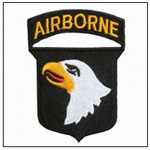 The
soldiers then as now doted on pets, some very odd indeed: a camel (who
was shot and killed), chickens (not all were eaten), a pig (he could
stand on his hind legs), a tame bear, dogs (Custer slept with his dogs
and the 34th Massachusetts had 40 dogs and was, naturally, called the
"Barking Dogs Regiment"), but the most famous mascot was "Old Abe" the
Battle Eagle, who served with the 8th Wisconsin Regiment through many
battles and many attempts on his life by Confederate snipers. Abe lived
until 1881. He was stuffed and put in a glass case in Madison. Abe lives
on: first atop the Vicksburg monument and second above the entrance to
Camp Randall, Wisconsin, and finally on the shoulder patch of the 101st
Airborne Division, the "Screaming Eagles." (pages 122-125) The
soldiers then as now doted on pets, some very odd indeed: a camel (who
was shot and killed), chickens (not all were eaten), a pig (he could
stand on his hind legs), a tame bear, dogs (Custer slept with his dogs
and the 34th Massachusetts had 40 dogs and was, naturally, called the
"Barking Dogs Regiment"), but the most famous mascot was "Old Abe" the
Battle Eagle, who served with the 8th Wisconsin Regiment through many
battles and many attempts on his life by Confederate snipers. Abe lived
until 1881. He was stuffed and put in a glass case in Madison. Abe lives
on: first atop the Vicksburg monument and second above the entrance to
Camp Randall, Wisconsin, and finally on the shoulder patch of the 101st
Airborne Division, the "Screaming Eagles." (pages 122-125)
Shells and bullets killed and wounded many soldiers and civilians,
but other scourges came with war: rain, mud, cold and heat, swarms of
mosquitoes and flies, the stench of garbage and overflowing latrines,
and, the worst, "the meanest water not fit for a horse." In such
conditions, diseases thrived – dysentery, measles, pneumonia, typhoid
fever, malaria and yellow fever. Improved sanitation reduced the toll of
typhoid fever and the use of quinine reduced the toll of malaria. Lice,
fleas, ticks and mites (scabies) also thrived.
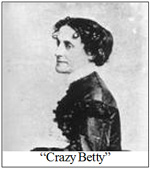 Espionage
came next, with Robertson saying that most would-be spies were less
James Bond than Maxwell Smart. Certainly, the first private detective,
Allan Pinkerton, did nab some Confederate spies, but his failure to
accurately gauge the strength of Lee’s army fed into McClellan’s natural
caution led him to ask for more troops, even when he outnumbered Lee
2-to-1. Pinkerton was fired along with McClellan. There were, however,
effective spies on both sides. Rose O’Neal Greenhow’s tip of Union plans
before First Manassas aided the Confederate victory. But the most
effective secret agent of all clearly was "Crazy Betsy," née
Elizabeth Van Lew, a Union sympathizer living in Richmond. She persuaded
Confederate officers to allow her to bring food to Union prisoners in
Libby Prison. Secreted in loaves of bread were directions to her house
should they escape. She left with secrets the prisoners had gleaned from
careless guards. She had a network of black slaves who worked in the
homes of Confederate officials. Such intelligence was sent with blacks
carrying parcels through Confederate lines to Union officers. Her most
incredible feat was to convert her mansion into a "fortress" with secret
passages and hiding places. She covered her tracks by pretending to be a
lunatic. At war’s end, Gen. Grant praised her for providing "the most
valuable information received from Richmond during the war." Grant
further infuriated Richmond’s citizens by appointing Van Lew as the
city’s postmaster. After Reconstruction ended, Richmond’s officials
seized her home and converted it into an insane asylum. She died in
1900, never seeing her old home again. Espionage
came next, with Robertson saying that most would-be spies were less
James Bond than Maxwell Smart. Certainly, the first private detective,
Allan Pinkerton, did nab some Confederate spies, but his failure to
accurately gauge the strength of Lee’s army fed into McClellan’s natural
caution led him to ask for more troops, even when he outnumbered Lee
2-to-1. Pinkerton was fired along with McClellan. There were, however,
effective spies on both sides. Rose O’Neal Greenhow’s tip of Union plans
before First Manassas aided the Confederate victory. But the most
effective secret agent of all clearly was "Crazy Betsy," née
Elizabeth Van Lew, a Union sympathizer living in Richmond. She persuaded
Confederate officers to allow her to bring food to Union prisoners in
Libby Prison. Secreted in loaves of bread were directions to her house
should they escape. She left with secrets the prisoners had gleaned from
careless guards. She had a network of black slaves who worked in the
homes of Confederate officials. Such intelligence was sent with blacks
carrying parcels through Confederate lines to Union officers. Her most
incredible feat was to convert her mansion into a "fortress" with secret
passages and hiding places. She covered her tracks by pretending to be a
lunatic. At war’s end, Gen. Grant praised her for providing "the most
valuable information received from Richmond during the war." Grant
further infuriated Richmond’s citizens by appointing Van Lew as the
city’s postmaster. After Reconstruction ended, Richmond’s officials
seized her home and converted it into an insane asylum. She died in
1900, never seeing her old home again.
Robertson chose Maj. Gen. George Pickett, as exemplifying that war
can bring out the best and the worst in people. Pickett is today known
almost exclusively for "leading" a doomed charge at Gettysburg, but the
worst came seven months later when in command of a botched raid on New
Bern, North Carolina. He captured 200 Federals, including 22 locals most
of whom had deserted from state home guard units, which was not
considered a crime in North Carolina. One was a 14-year old drummer boy.
Pickett was angry over the failure of his raid and executed all 22 as
deserters. The corpses were stripped and thrown into a mass grave. The
best that could be said about George Pickett was that the incident
revealed him at his worst.
To punish Robert E. Lee for siding with Virginia, a former friend,
Union Quartermaster General Montgomery Meigs seized the Custis-Lee
Mansion for use a settlement for former slaves and as a cemetery. Meigs
took "grim satisfaction" in placing the graves as close as possible to
the mansion so it could never be used as a residence. In 1882, the U. S.
Supreme Court returned the property to Lee’s oldest son, who had little
choice but to sell it to the government for $150,000. Not until 1900
were Confederate soldiers allowed to be buried in Arlington National
Cemetery and in 1955 Arlington House was dedicated as a memorial to
Robert E. Lee. Over 240,000 dead lie in the 600-acre tract and an
average of 18 funerals occur there daily.
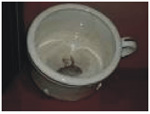 Now
we were reintroduced to your editor’s favorite Civil War scoundrel,
Benjamin Franklin Butler. With no prior military experience (or
ability), Lincoln appointed this prominent and influential Northern War
Democrat as the Union’s first Major General. Wherever he went, Butler
snatched defeat from the jaws of victory. However, he was also
innovative: rather than return escaped slaves to their masters, he
called them "contraband" and put them to work on his side (we call this
a "twofer:" enhancing the Union’s forces and reducing the Confederacy’s
forces). And as Military Governor of New Orleans, he improved the
sanitation and reduced typhoid fever, etc. He was called "Spoons" (for
confiscating Southerners’ silver services), but as "Beast" (for issuing
an order to treat New Orleans women who spat on or dumped chamber pots
on the heads of Union troops as prostitutes), Butler reached the heights
when Jefferson Davis issued a "fatwah" that Butler was to be shot on
sight. New Orleans’ prostitutes got the last laugh: you can purchase
your own for $52.50 from the Confederate Memorial Hall Museum in New
Orleans. Now
we were reintroduced to your editor’s favorite Civil War scoundrel,
Benjamin Franklin Butler. With no prior military experience (or
ability), Lincoln appointed this prominent and influential Northern War
Democrat as the Union’s first Major General. Wherever he went, Butler
snatched defeat from the jaws of victory. However, he was also
innovative: rather than return escaped slaves to their masters, he
called them "contraband" and put them to work on his side (we call this
a "twofer:" enhancing the Union’s forces and reducing the Confederacy’s
forces). And as Military Governor of New Orleans, he improved the
sanitation and reduced typhoid fever, etc. He was called "Spoons" (for
confiscating Southerners’ silver services), but as "Beast" (for issuing
an order to treat New Orleans women who spat on or dumped chamber pots
on the heads of Union troops as prostitutes), Butler reached the heights
when Jefferson Davis issued a "fatwah" that Butler was to be shot on
sight. New Orleans’ prostitutes got the last laugh: you can purchase
your own for $52.50 from the Confederate Memorial Hall Museum in New
Orleans.
The Civil War was a war of firsts: it changed everything in American
life. Where before uniforms and shoes were "one size fits all" Union
Quartermaster Meigs ordered them made in small, medium, large and extra
large. Women both North and South could now hold title to real estate,
worked in
 factories
(where they influenced the introduction of safety measures), became
school teachers and school mistresses and nurses. Phoebe Pember in
Richmond and Clara Baron in the North both had to overcome the rudeness
and contempt of surgeons and patients to become superb administrators.
The 13th, 14th and 15th Amendments raised women, along with blacks, at
least to legal equality. factories
(where they influenced the introduction of safety measures), became
school teachers and school mistresses and nurses. Phoebe Pember in
Richmond and Clara Baron in the North both had to overcome the rudeness
and contempt of surgeons and patients to become superb administrators.
The 13th, 14th and 15th Amendments raised women, along with blacks, at
least to legal equality.
One man, Thomas Nast, brought the art of cartoons to the fore. He
hated corrupt politicians and skewered them (see Boss Tweed). He also
introduced the donkey and the elephant as political party emblems and
Uncle Sam and John Bull. But he is most famous for "inventing" Santa
Claus. Christmas 1862 was a sad and gloomy season and Nast mused, what
can I do? He drew Santa as a round-bellied, white-bearded, fur-clad and,
most important, jolly and bight eyed, with a sprig of holly in his hat.
The effect on his public was electric; his image lasts to this day.
 Horses
and mules were the main mode of transportation in the Civil War on both
sides, although the North had an advantage in both trains and water
vessels. Contrary to Hollywood, the soldiers on both sides were told
when facing a cavalry charge, "Shoot the horse first!" That put the
rider on foot and equalized the sides. Despite General Sherman’s orders
to take "extraordinary care . . . of the horses upon which everything
depends" horses and mules more often than not were abused out of
necessity or indifference. The National Sporting Library in Middleburg,
Virginia commissioned a monument to the Civil War cavalry horse. Rather
than portray a hearty horse, the monument shows an exhausted,
malnourished horse, still faithful and serving, even though it was
clearly near the end of its rope. We don't know what happened to its
master. The monument accurately depicts the condition of Civil War
cavalry horses, and shows the frightful toll that endless hours of
marching and picketing took on those proud beasts. There is an identical
statute at the U. S. Cavalry Museum in Fort Riley, Kansas, Horses
and mules were the main mode of transportation in the Civil War on both
sides, although the North had an advantage in both trains and water
vessels. Contrary to Hollywood, the soldiers on both sides were told
when facing a cavalry charge, "Shoot the horse first!" That put the
rider on foot and equalized the sides. Despite General Sherman’s orders
to take "extraordinary care . . . of the horses upon which everything
depends" horses and mules more often than not were abused out of
necessity or indifference. The National Sporting Library in Middleburg,
Virginia commissioned a monument to the Civil War cavalry horse. Rather
than portray a hearty horse, the monument shows an exhausted,
malnourished horse, still faithful and serving, even though it was
clearly near the end of its rope. We don't know what happened to its
master. The monument accurately depicts the condition of Civil War
cavalry horses, and shows the frightful toll that endless hours of
marching and picketing took on those proud beasts. There is an identical
statute at the U. S. Cavalry Museum in Fort Riley, Kansas,
 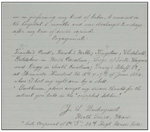 William
Oland Bourne, editor of the periodical The Soldier's Friend,
sponsored two contests in which Union soldiers and sailors who lost
their right arms by disability or amputation during the Civil War were
invited to submit samples of their penmanship using their left hands.
Cash prizes totaled $1000 for the first contest and $500 for the second.
An exhibition of all first contest entrants was held in Washington,
D.C., on May 1, 1866. Private J. S. Prendergast, Co. F. 24th
Massachusetts Infantry, won $20 for this submission. The contest
brochure revealed that Prendergast not only lost his right arm but "two
fingers and part of the thumb of the left hand." William
Oland Bourne, editor of the periodical The Soldier's Friend,
sponsored two contests in which Union soldiers and sailors who lost
their right arms by disability or amputation during the Civil War were
invited to submit samples of their penmanship using their left hands.
Cash prizes totaled $1000 for the first contest and $500 for the second.
An exhibition of all first contest entrants was held in Washington,
D.C., on May 1, 1866. Private J. S. Prendergast, Co. F. 24th
Massachusetts Infantry, won $20 for this submission. The contest
brochure revealed that Prendergast not only lost his right arm but "two
fingers and part of the thumb of the left hand."
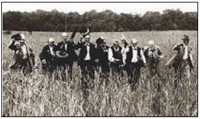  There
was a second Civil War: Reconstruction (1867-76), marked by the only
military occupation of Americans by Americans. Don’t blame some then and
now for being resentful. But as time went on a strange and wonderful
thing happened to the veterans. The survivors began to appreciate what
the other sides had done and suffered. Johnny Reb never apologized and
Billy Yank never asked for one. Pictures taken at the 50th anniversary
of the Battle of Gettysburg tell the story. The rebel "charge" at the
right was met by Union vets cheering and waving their hats! The favorite
song at this reunion was "Auld Lang Syne" not the rousing songs used to
stir youths to battle. The last chorus is
à propos: There
was a second Civil War: Reconstruction (1867-76), marked by the only
military occupation of Americans by Americans. Don’t blame some then and
now for being resentful. But as time went on a strange and wonderful
thing happened to the veterans. The survivors began to appreciate what
the other sides had done and suffered. Johnny Reb never apologized and
Billy Yank never asked for one. Pictures taken at the 50th anniversary
of the Battle of Gettysburg tell the story. The rebel "charge" at the
right was met by Union vets cheering and waving their hats! The favorite
song at this reunion was "Auld Lang Syne" not the rousing songs used to
stir youths to battle. The last chorus is
à propos:
And there’s a hand my trusty friend! And give me a
hand o’ thine!
And we’ll take a right good-will draught for Auld Lang Syne.
Prof. Robertson wrapped up his presentation by
saying, "With all that we gained, we also lost the contributions of the
dead in science, the arts, medicine and, saddest of all, their children
and grandchildren, who might have been.
He added this personal postscript: "Our Constitution,
as amended, is a wonderful tool for practicing democracy. However,
creating it required the various factions to compromise. The Civil War
came on because the various factions longer valued compromise. I worry
that we are entering a phase in our history where the factions again no
longer value compromise."
Vigorous questions and answers followed, and the
evening ended with a very spirited round of applause.
Last changed: 04/04/14
Home
About News
Newsletters
Calendar
Memories
Links Join
|

